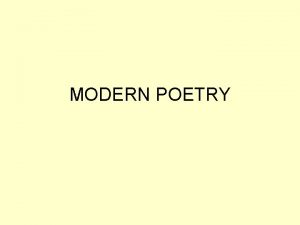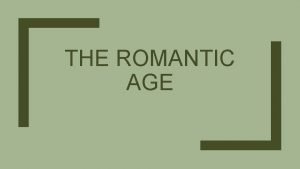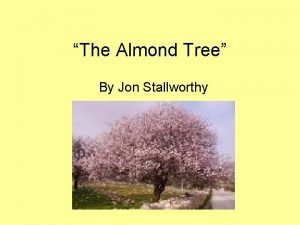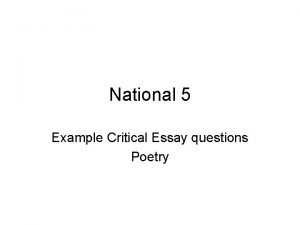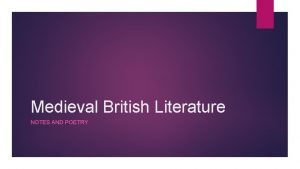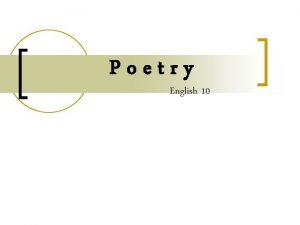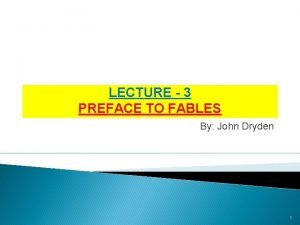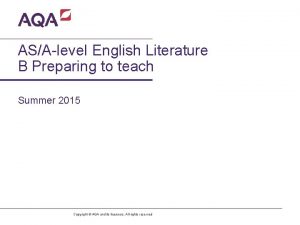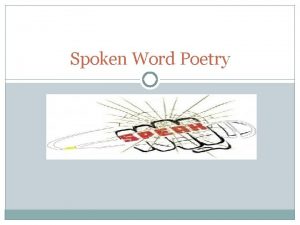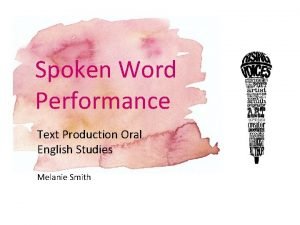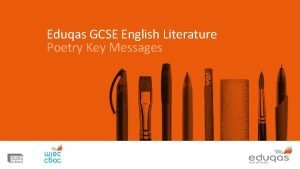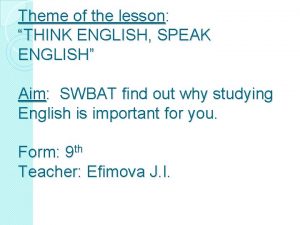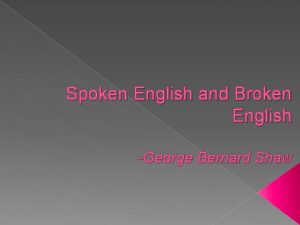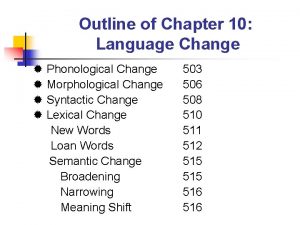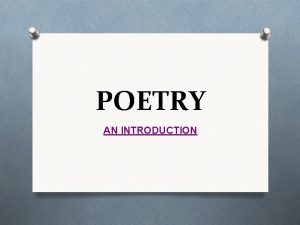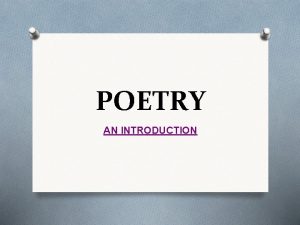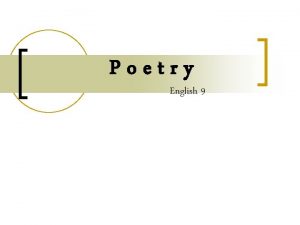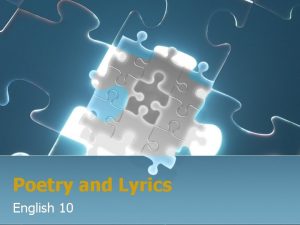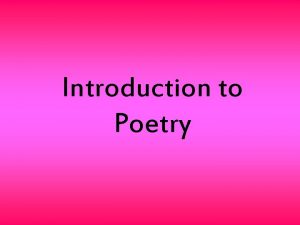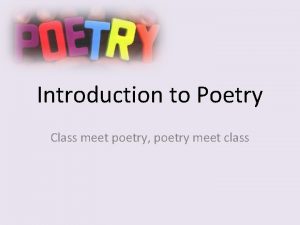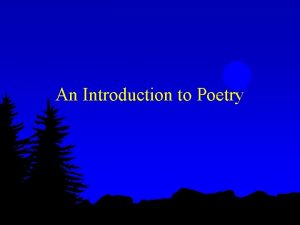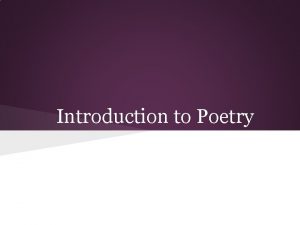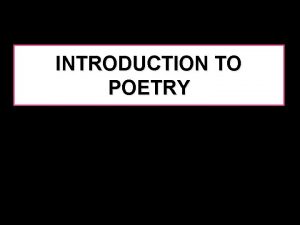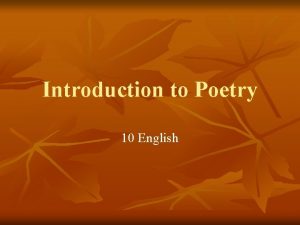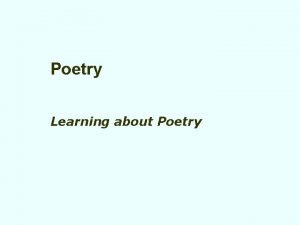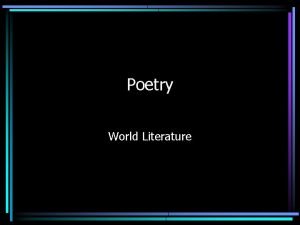INTRODUCTION TO POETRY English 12 WHAT IS POETRY



















- Slides: 19

INTRODUCTION TO POETRY English 12

WHAT IS POETRY? • “Memorable Speech” – W. H. Auden • “The spontaneous overflow of powerful feelings” – William Wordsworth • “Untranslatable speech” – Robert Frost • Poetry attempts to capture that instant when you feel that emotion but cannot articulate that feeling into words – A good poet uses emotional experiences with which his or her reader is familiar, and explains them. • Poetry should make us feel, wonder, engage with ideas, and give us moments of clarity within an often complex and confusing world.

CLASSES OF POETRY • Three Classifications: 1. Dramatic: All poetry written for the stage, such as Tragedy, Comedy, Opera, and Melodrama. (ex: Shakespeare’s Romeo and Juliet) 2. Narrative: Poetry that contains a story. - Epic: a long poem that tells a story of heroic deeds or events that are important to the author’s culture. (ex. Homer’s “The Iliad” and “The Oddyssey”) - Ballad: a poem or song, usually written in short stanzas, that tells a story. (ex: Can you think of a current song that does this? )

LYRIC POEMS 3. Lyric: The most common type of poetry, which centres on thoughts and emotions. These are usually short and written in stanza form. - The Ode: a public expression of praise. Usually has a repeating stanza. - Elegy: a poem of lamentation, expressing grief of personal loss, or of changes over time. They can also be contemplations on the tragic aspects of life. How fast our hair grows gray! Before we pray Our evening prayer, the night falls. Death calls Our name Before coming success and fame.

TYPES OF LYRIC POEMS -Sonnet: a fourteen line poem usually written in rhymed iambic pentameter. Usually expresses a single theme or idea. Two structures: a abba (for example, the octave). and a rhyme in a. Petrarchan (Italian): an octave (8 line stanza) and sestet (6 line stanza) written in the rhyme scheme cdecde. Each stanza has a particular purpose the sestet may answer a question posed in b. Shakespearean: three quatrains (4 line stanza) concluding couplet (2 line stanza) written in the scheme abab cdcd efef gg. These are always written Iambic Pentameter. The couplet is usually a

SHAKESPEAREAN SONNET

TYPES OF LYRIC POEMS • Descriptive Lyric: tells a story, but the emotional value of the story is more important than the events. • The Pastoral: expresses the yearning for an innocence and simplicity that have been lost in the big city.

TYPES OF LYRIC POEMS • Didactic is literature or poetry that is meant to teach, particularly in having moral instruction as an ulterior motive. (ex. The Bible uses stories to teach Christians how to behave). • Epigram – a short poem or verse that makes a statement, usually using satire and wit. Ex: “swans sing before they die- ‘twere no bad thing/ Should certain people die before they sing!”

STRUCTURE OF A POEM • Stanza: a sequence of lines that form a metrical (rhyming), tonal, or intellectual unit. It is based on number of lines: • Couplet = 2 lines, Triplet = 3 lines, Quatrain = 4 lines, Cinquain = 5 lines, Sestet = 6 lines, etc. • Special types based on Rhythm: Rhyme Royal: 7 lines in Iambic Pentameter Ottava Rhyme: 8 lines in Iambic Pentameter • Spensarian Stanza: 9 lines

RHYME Types of Verse • Blank Verse – has rhythm, but no rhyme. Hint: imagine you have a series of blanks to fill in in order to have enough syllables in a line. • Free Verse – No rhythm or rhyme. Hint: you are free to write however you please. • Rhyming Verse – Has a repeating rhyme scheme (labelled using a letter to correspond with each new rhyme). Her eyes shone (a) Like the sun (a) But during day (b) They hid away (b)

RHYME Types of Rhyme: • Perfect = looks the same and sounds the same (ex. Hat/Rat, Marriage/Carriage) • Irregular = Can either sound the same or look the same (ex. Break/Snake, or Home/Come) • Rich = a word is used to rhyme with itself • Internal = a rhyme within a line (ex. You ate the cake I had to make) • Consonance = rhyme created using repeated consonants within a line (ex. Pitter Patter)

METER Meter is a regular pattern of stressed and unstressed syllables • The unit of meter is called a foot – this foot consists of a stressed syllable and one or two unstressed syllables that precede or follow it. • The number of feet in a line determines the name of the meter: one foot = monometer, two = dimeter, 3 = trimeter, 4 = tetrameter, 5 = pentameter, 6 = hexameter, 7 = heptameter, 8 = octometer, etc. Ex: the goat ate grass = dimeter Ex: To be or not to be = trimeter

TYPES OF FEET 1. Iambic – the most common type of English verse, the foot contains one unstressed syllable followed by a stressed. (ex. sur. PRISE) 2. Trochee – a stressed syllable followed by an unstressed (ex. SPLASHing) 3. Anapest – two unstressed syllables followed by a stressed (ex. inter. VENE). 4. Dactyle – one stressed syllable followed by two unstressed (ex. DELicate)

LET’S PRACTICE On your piece of paper write the numbers 1 -4. For each of the following examples record which of the four feet types you think it is (Iambic, Trochee, Anapest, Dactyl). We will go over the answers afterwards. Example 1: He was prouder than the devil How he must have cursed our revel

PRACTICE Example 2: Here’s to the widow of fifty years

PRACTICE Example 3: But now secure the painted vessel glides The sun beams trembling on the floating tides

PRACTICE Example 4: From the center all round to the sea I am lord of the fowl and the brute

ANSWERS He was prouder than the devil How he must have cursed our revel = Trochee Here’s to the widow of fifty years = Dactyl

ANSWERS But now secure the painted vessel glides The sun beams trembling on the floating tides = Iambic From the center all round to the sea I am lord of the fowl and the brute = Anapest
 Metaphysical and cavalier poets
Metaphysical and cavalier poets Traditional poetry vs modern poetry
Traditional poetry vs modern poetry Types of lyric poetry
Types of lyric poetry Augustan and romantic literature
Augustan and romantic literature Poetry poetry
Poetry poetry Nat 5 critical essay questions poetry
Nat 5 critical essay questions poetry Medieval poetry notes
Medieval poetry notes Crocus poem
Crocus poem English edexcel literature paper 1
English edexcel literature paper 1 Allama iqbal philosophy of education
Allama iqbal philosophy of education Personification in poetry meaning
Personification in poetry meaning Preface to the fables by john dryden summary
Preface to the fables by john dryden summary Characteristics of romantic literature
Characteristics of romantic literature Aqa a level english literature b past papers
Aqa a level english literature b past papers Spoken poetry english
Spoken poetry english Oral english text
Oral english text Yesterday by patricia pogson analysis
Yesterday by patricia pogson analysis Think in english speak in english
Think in english speak in english Spoken english and broken english
Spoken english and broken english Semantic change
Semantic change

